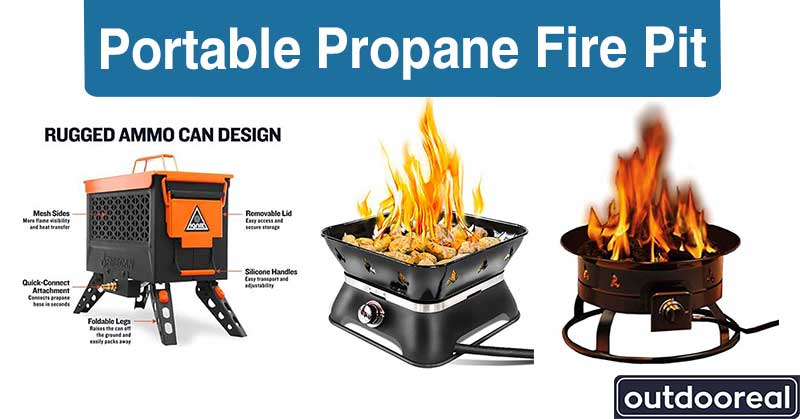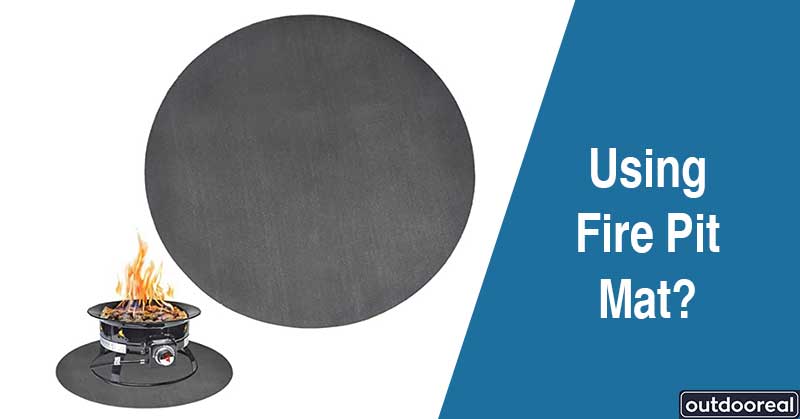Fuel type determines essential facts like heat output, safety, user experience, etc., for a fire pit. We have researched the fuels of different fire pits and found Smoak Firewood Cooking Wood Logs – USDA Certified Kiln Dried as the best heat-producing one. Pine Mountain 6PK 2HR Trad Fire Log is a real money saver and a good value for money.
While propane is the safest fuel, Coleman Propane Fuel, 16 oz, Propane Camping Cylinder 4-Pack.
It is a good propane tank for a fire pit. And for people seeking smokeless fuel, Colsen Fireplace Fuel, Ventless, Bio-Ethanol is the best and most intelligent choice.
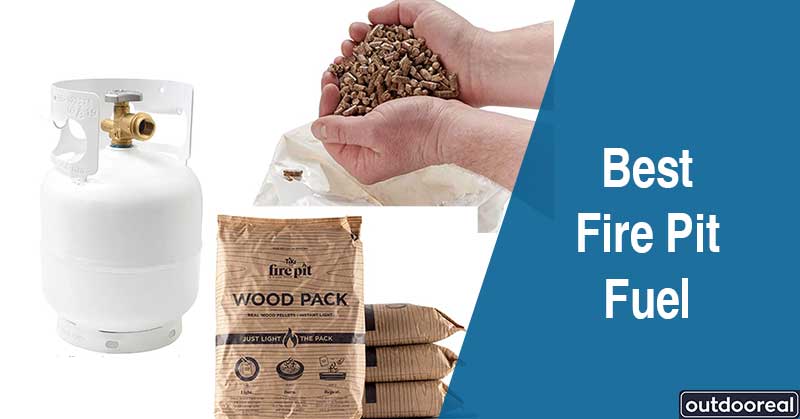
What are the Types of Fuel Used for Fire Pits?
Even though there are many different styles and designs for outdoor fire pits, there are usually only four fuel options: wood, natural gas, propane, and gel fuel.
A wood-burning fire pit uses a different type of wood available online and offline. The most heat-producing fuel is firewood. At the same time, propane and gas fire pits have no option but to use a definite type of fuel for fire pit.
Best Fire Pit Fuels
A. Best Heat Producing Fuel:
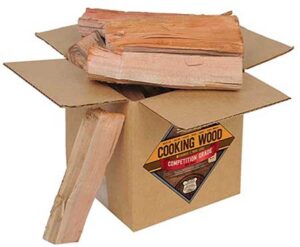
Smoak Firewood Cooking Wood Logs – USDA Certified Kiln Dried
We selected this because this firewood is maple and well known for producing enormous heat. Each log is about 8 inches and provides an excellent experience for anybody wishing to enjoy warmth and cooking.
Pros of the Smoak Firewood Cooking Wood Logs:
- Provide a pleasant warm experience with an enormous heat output
- Perfect for cooking in a fire pit
Cons of the Smoak Firewood Cooking Wood Logs:
- Produces smoke
- It can not be used in any gas fire pits.
B. Best Cost Effective Fuel:
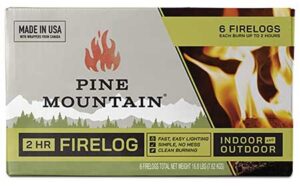
Pine Mountain 6PK 2HR Trad Fire Log
Pine Mountain Traditional firelogs light quickly and provide considerable heat for the given quality. Pine Mountain firelogs burn faster, easier, and cleaner than real firewood. We have considered this one for its excellent performance and customer satisfaction. This pack provides 6 logs, which have 2 hours of burn time. Which sometimes burns more than 3 hours!
Pros of the Pine Mountain 6PK 2HR Trad Fire Log:
- Cleaner to burn than wood; it produces less carbon and smoke.
- It Produces an enormous amount of heat like real hardwood.
- Natural hardwoods were used to make it.
- Environment-friendly and easily affordable.
- Great for campfires, fireplaces, and fire pits.
- 2-hour burning time
Cons of the Pine Mountain 6PK 2HR Trad Fire Log :
- Some of the logs may be hard to burn.
- You can not use it in any fire pit other than wood-burning fire pits.
C. Safest Fuel:
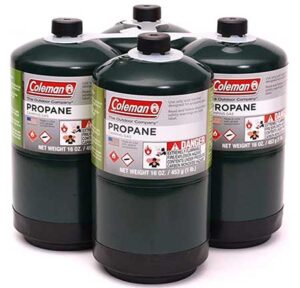
Coleman Propane Fuel, 16 oz, Propane Camping Cylinder 4-Pack
Propane is the best safe fuel for fire pits as they do not produce embers. We have selected this one for its convenience-free 4-cylinder combo pack and quality.
Pros of the Coleman Propane Fuel, 16 oz, Propane Camping Cylinder 4-Pack:
- Safe and easy to use
- Fine performance according to the price
3. Perfect for any outdoor or indoor propane fire pit
Cons of this fuel:
- You can only use this with propane or gas fire pits.
D. Smokeless Fuel:
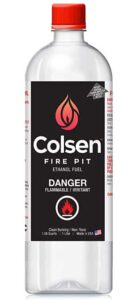
Colsen Fireplace Fuel, Ventless, Bio-Ethanol
It is the cleanest fuel for a fireplace that doesn’t make smoke. Colsen was made just for indoor fireplaces without vents, and it is entirely environment-friendly. It is a clean, sustainable bio-ethanol fuel that follows all rules the U.S. Government sets.
Pros of the Colsen Fireplace Fuel, Ventless, Bio-Ethanol fuel:
- Very well packaged and easy to use
- Burns clean and do not produce smoke
- Affordable
Cons of the Colsen Fireplace Fuel, Ventless, Bio-Ethanol fuel:
- You can use it only in tabletop or ethanol-supported fire pits
What is the Best Smokeless Fuel for Fire Pit?
Propane and gas fire pits produce significantly less smoke than wood-burning fire pits. If you want to think about what would be best for the environment, the ethanol fire pit is the best choice. Ethanol is a biofuel that burns cleanly and has two significant benefits.
First, it does not have a smell or odor that some people find bothersome and annoying.
Second, bio-ethanol is an expensive option and is best for indoor usage.
Which Fuel Produces Much Higher Heat?
Wood gives off more heat than propane or natural gas because it burns hotter. This also means cooking outside with a wood-burning stove is more accessible than with a gas stove. Dense woods, for example, maple, hickory, and oak, generate the most BTUs. Most of the time, wood pits are the best way to get the most heat because they can make an enormous fire than a gas burner. Some people think that wood fires smell as good as they look, but others think the smoke and particles they give off are a health risk.
What is the Safest Fuel for a Fire Pit?
Natural gas and propane fire pits are safer than wood fires while keeping many of the good things about wood fires. Wood fire pits are much more dangerous than gas fire pits. They will burn cleanly and won’t need wood or anything else to keep the fire going. There won’t be any flying fire sparks or unpredictable fire flames like there would be with a wood fire pit.
What is the best fuel to start a fire?
For a wood-burning fire pit, you can try starting the fire with this quick fire starter fuels;
Tissue roll-
If you have a used tissue, roll cardboard, put some tissue inside the hollow space, put the igniter on the tissue inside, and place it in the fire pit. It will create some smoke at first, but the fire will start quickly.
Potato or corn chips-
Everyone loves sliced crisps, and you can start the fire with them! Just lay 5-6 thin chips and put fire on them. Gather fuels around or beneath it; the fire will spread quickly.
Egg cartoons-
Many of us have unused paper egg cartoons in the house, so tear them apart, put some petroleum jelly (that you use for your lips) in the cavities, and fire them. The fire will be fast and long.
Orange peels-
If you have some citrus in the fridge, peel them and dry them. Then, put the fire on them; the peels will burn with the citrus oil, and you will get a pleasant aroma while the fire pit burns!
For gas or propane fire pits, if the ignitor does not work, then using the below-mentioned ignitor will come in handy;
Flint and steel striker-
A flint rod ignites a fire by striking it on the ground or other sharp surfaces to create sparks. Some include spring-loaded devices that remove the rod’s coating, making it simpler and quicker to spark.
Rechargeable lighter-
Nowadays, people love rechargeable lighter more than anything. They come in trendy designs and start the fire quickly and safely.
What Fuel to Use in My Fire Pit?
If you have a wood-burning fire pit, only use dry, high-quality wood to minimize smoke and maximize heat output.
We advise using Kiln-Dried Logs, which can be purchased offline or online. There’s no alternative for a propane or gas fire pit, but it is best never to use anything other than the fuel it is designed for. For gel fuel fire pits, there are some fuel cans out there; you can try.
Final Verdict
Deciding the best fuel for a fire pit can often be confusing and challenging, as different types of fire pits are designed for different types of energy. For wood-burning fire pits, there are usually lots of options. However, you cannot use any alternatives for table tops, gas, or propane fire pits; instead, choosing the best brand is a good decision.



